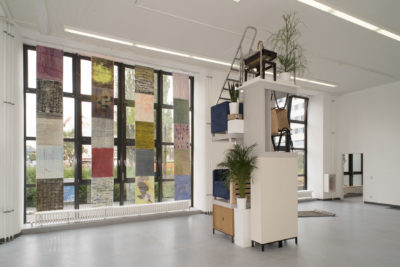Timea Anita Oravecz
L’ombra delle cose. Die Frage nach der Bedeutung, Notwendigkeit oder gar Überflüssigkeit von Besitz ist der Gegenstand, mit dem Timea Anita Oravecz in die »Post-Otherness-WG» einzieht,. Aus der Sicht einer marxistischen Kommune, ist die völlige Aufgabe des Privateigentums gleichwohl am wichtigsten, um ein kollektives Zusammenleben überhaupt erst möglich oder umgekehrt auch unmöglich zu machen. Sie platziert diese Frage mitten in den Ausstellungsraum, indem sie vor Ort im Keller oder Abstellraum vorgefundene Möbel, zu einer Rauminstallation verbaut, unbrauchbar macht und damit ihre Sperrigkeit auch radikal neu kontextualisiert. Deren vermeintlichen Anspruch auf Platz/Raum führt Ovarecz durch ihre skulpturale »Erhöhung« auf minimaler Fläche bildhaft ad absurdum.
english version
L’ombra delle cose. (the shadow of things) The question of the meaning, necessity or even superfluousness of property is the subject Timea Anita Oravecz brings to the Post-Otherness flat share, and, from a marxist communal perspective, it is a most crucial aspect: making collective life together possible to begin with or, alternatively, impossible. She puts this issue right at the centre of the exhibition space, by building an installation of disused furniture found in the basement and storage space on site, effectively rendering the pieces useless while radically re-contextualising their bulkiness. Their apparent claim for room is symbolically lead ad absurdum by Oravecz through their sculptural »elevation« in limited space.
Biografie/ Biography
Timea Anita Oravecz
Webseite der Künstlerin/ Website of the Artist
http://www.timeaoravecz.com/
„The house is a fetishist symbol of bourgeoisie. One normally thinks that the house represents a „safe harbor “ from everyday problems, but often one remains imprisoned in the insane urge to own more and more. Our lives seem to be now dominated by a kind of „bulimia “ in which we accumulate relentlessly and then throw it all away within a short time . The installation would be a monument against capitalist society that claims to dominate the man providing it with unnecessary goods and , at the same time , erasing his real freedom and forcing him to go into debt to pay even his own home. The objects are not acquired by necessity but because they represents a „status symbol “ within the bourgeois society. The artist was inspired by the works of Georges Perec , György Lukács and Michel Foucault and their anti – consumerist theories.“ (Timea Oravecz)
Reference Pircture: Tetrix wardrobe, Timea Oravecz

Installation view (c) Holger Herschel
















